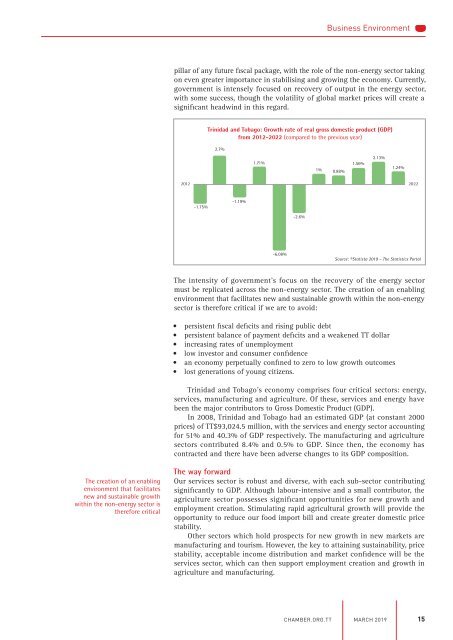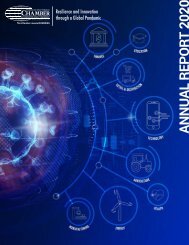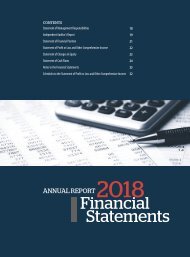Contact_Vol19No1_March2019_WEB full and final
Create successful ePaper yourself
Turn your PDF publications into a flip-book with our unique Google optimized e-Paper software.
Business Environment<br />
pillar of any future fiscal package, with the role of the non-energy sector taking<br />
on even greater importance in stabilising <strong>and</strong> growing the economy. Currently,<br />
government is intensely focused on recovery of output in the energy sector,<br />
with some success, though the volatility of global market prices will create a<br />
significant headwind in this regard.<br />
Trinidad <strong>and</strong> Tobago: Growth rate of real gross domestic product (GDP)<br />
from 2012-2022 (compared to the previous year)<br />
2.7%<br />
1.71%<br />
1% 0.88%<br />
1.56%<br />
2.13%<br />
1.24%<br />
2012 2022<br />
-1.75%<br />
-1.19%<br />
-2.6%<br />
-6.08%<br />
Source: ©Statista 2019 – The Statistics Portal<br />
The intensity of government’s focus on the recovery of the energy sector<br />
must be replicated across the non-energy sector. The creation of an enabling<br />
environment that facilitates new <strong>and</strong> sustainable growth within the non-energy<br />
sector is therefore critical if we are to avoid:<br />
• persistent fiscal deficits <strong>and</strong> rising public debt<br />
• persistent balance of payment deficits <strong>and</strong> a weakened TT dollar<br />
• increasing rates of unemployment<br />
• low investor <strong>and</strong> consumer confidence<br />
• an economy perpetually confined to zero to low growth outcomes<br />
• lost generations of young citizens.<br />
Trinidad <strong>and</strong> Tobago’s economy comprises four critical sectors: energy,<br />
services, manufacturing <strong>and</strong> agriculture. Of these, services <strong>and</strong> energy have<br />
been the major contributors to Gross Domestic Product (GDP).<br />
In 2008, Trinidad <strong>and</strong> Tobago had an estimated GDP (at constant 2000<br />
prices) of TT$93,024.5 million, with the services <strong>and</strong> energy sector accounting<br />
for 51% <strong>and</strong> 40.3% of GDP respectively. The manufacturing <strong>and</strong> agriculture<br />
sectors contributed 8.4% <strong>and</strong> 0.5% to GDP. Since then, the economy has<br />
contracted <strong>and</strong> there have been adverse changes to its GDP composition.<br />
The creation of an enabling<br />
environment that facilitates<br />
new <strong>and</strong> sustainable growth<br />
within the non-energy sector is<br />
therefore critical<br />
The way forward<br />
Our services sector is robust <strong>and</strong> diverse, with each sub-sector contributing<br />
significantly to GDP. Although labour-intensive <strong>and</strong> a small contributor, the<br />
agriculture sector possesses significant opportunities for new growth <strong>and</strong><br />
employment creation. Stimulating rapid agricultural growth will provide the<br />
opportunity to reduce our food import bill <strong>and</strong> create greater domestic price<br />
stability.<br />
Other sectors which hold prospects for new growth in new markets are<br />
manufacturing <strong>and</strong> tourism. However, the key to attaining sustainability, price<br />
stability, acceptable income distribution <strong>and</strong> market confidence will be the<br />
services sector, which can then support employment creation <strong>and</strong> growth in<br />
agriculture <strong>and</strong> manufacturing.<br />
CHAMBER.ORG.TT<br />
MARCH 2019 15
















